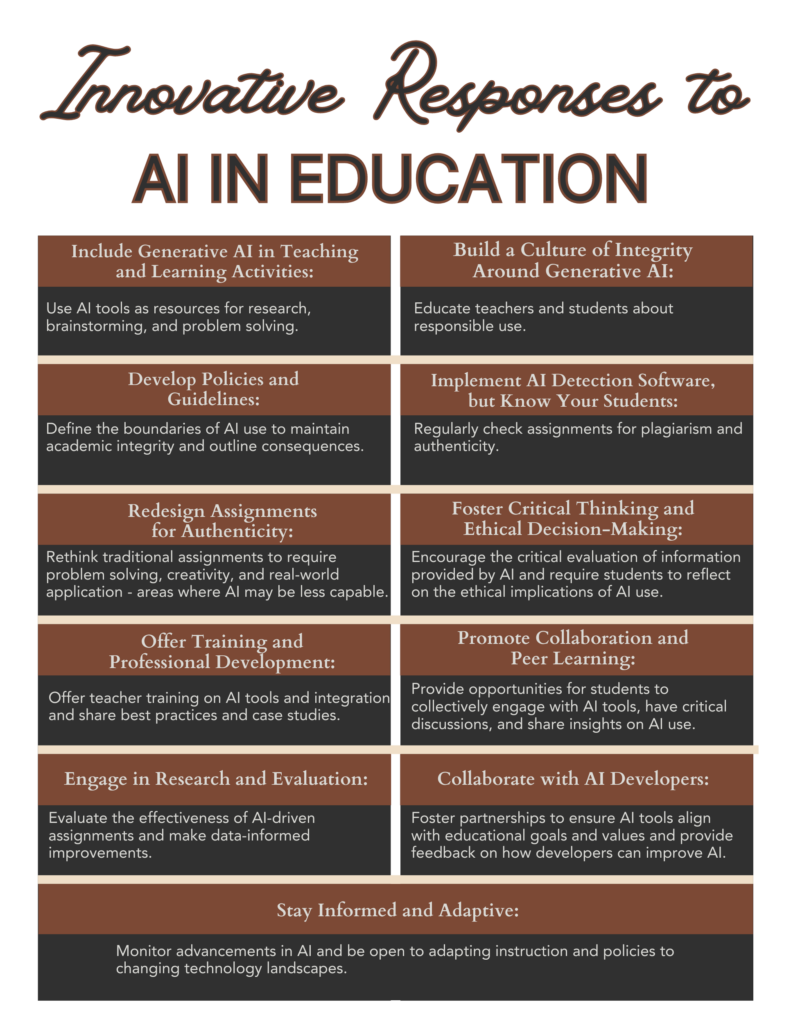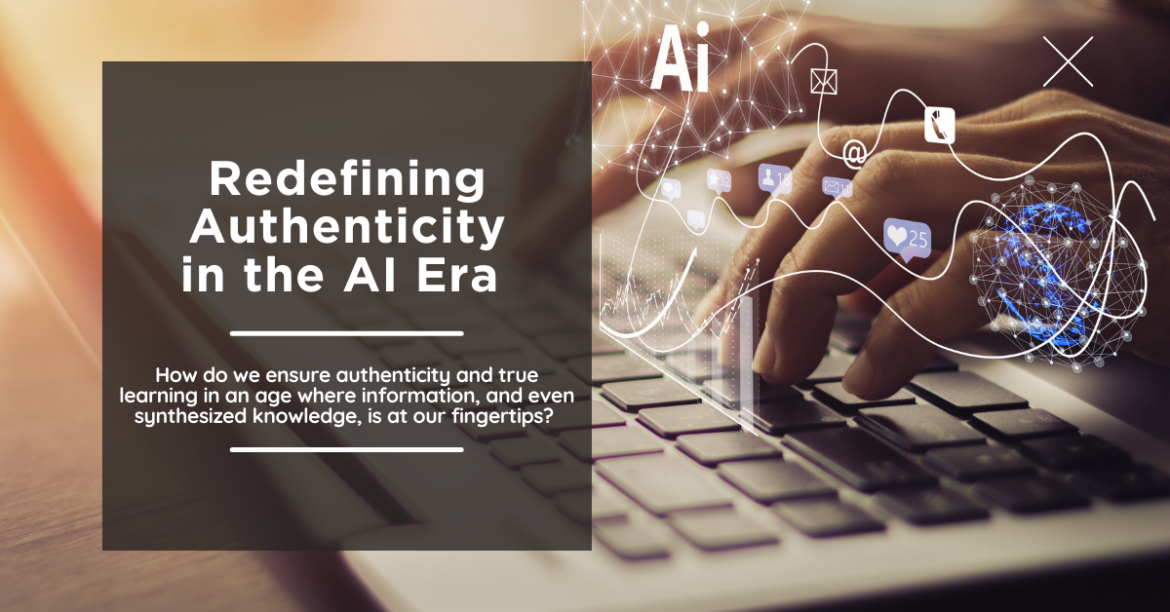Since just before the dawn of the 21st century, advances in digital technologies, like artificial intelligence (AI), have triggered the need for innovative changes in the physical, communicative, and epistemic structures of classrooms and learning environments. With the realization that teaching and learning could happen anywhere, instructors began to transform their pedagogies to be more reflexive by:
- Flipping the Classroom
- Providing Online Discussions
- Integrating Multimedia Content
- Personalizing Lectures
- Delivering Real-time Feedback
- Cultivating Collaborative Intelligence
- Offering Blended Learning
- Supplying Accessible Learning Materials
- Harnessing Data-driven Insights
- Embracing Continuous Assessment
- Promoting Equity-Minded Teaching
Likewise, as of 2023, we as educators find ourselves adapting to advancements in new and disruptive digital technologies like generative AI (e.g., ChatGPT). Its expansive capabilities mean students can potentially use ChatGPT to complete traditional homework assignments, from simple math problems to crafting detailed research papers, all without necessarily understanding or engaging with the underlying academic content.
This advance in digital technology poses both an opportunity and a challenge for educators. While this technology can be an incredible resource for deepening understanding and expanding horizons, it also calls into question the very nature of traditional assignments and assessments. Let’s explore an important question and actionable steps for addressing this question as we move into the generative AI era of education: How do we ensure authenticity and true learning in an age where information, and even synthesized knowledge, is at our fingertips?

What Is an AI-Integrated Authentic Assignment?
The rise of advanced AI systems, like generative AI, further underscores the need for authentic tasks. As these systems can easily replicate routine tasks, the focus in education now shifts even more towards fostering skills that AI can’t easily replace. Authentic tasks, with their emphasis on human-centric skills, gained further importance in this context. Before looking at actionable steps for harnessing the power of AI while ensuring meaningful learning, I propose an updated definition of authentic assignments that incorporates generative AI as an authentic teaching tool:
Authentic assignments:
- Reflect real-world challenges and require the application of knowledge and skills, rather than just rote memorization.
- Relevant and meaningful, allowing students to engage deeply with content and draw connections between their learning and its application in practical, real-world contexts (Herrington & Herrington, 2006; Lombardi, 2007).
- Integrate AI tools to promote digital literacy and AI collaboration with an emphasis on ethical reasoning, critical thinking, collaboration, emotional intelligence, and human-centric skills.
- Foster deep engagement, adaptability, and continuous learning, preparing students with 21st-century skills in a dynamically evolving technological world.
Actionable Steps to Take

Innovations in generative AI call for innovative responses as this technology further changes the role of instructors and students and the skills that advance them. Let’s look at innovative responses to recent advances in generative AI.
1. Include Generative AI in Teaching and Learning Activities:
- Integrate generative AI tools like ChatGPT as a resource in the classroom.
- Encourage students to use AI for research, brainstorming, and problem solving, while emphasizing its role as a tool to aid understanding, not replace it.
2. Build a Culture of Integrity Around Generative AI:
- Educate both educators and students about the responsible use of AI.
- Emphasize the importance of using AI as a supplement to learning, rather than a shortcut to complete assignments without understanding the material.
3. Develop Policies and Guidelines:
- Establish clear policies and guidelines for the use of generative AI in educational settings.
- Define the boundaries of AI usage to maintain academic integrity.
- Address issues such as plagiarism, proper citation of AI-generated content, and consequences for misuse.
4. Implement AI Detection Software, but Know Your Students:
- Utilize AI detection tools designed to identify AI-generated or plagiarized content.
- Regularly check assignments and projects to ensure they meet academic standards and authenticity.
5. Redesign Assignments for Authenticity:
- Rethink traditional assignments to align them with authentic learning experiences.
- Design assignments that require problem solving, creativity, and real-world application, areas where AI may be less capable.
6. Foster Critical Thinking and Ethical Decision-Making:
- Emphasize the importance of critical thinking and ethical decision-making alongside AI integration.
- Encourage students to question and evaluate the information provided by AI tools.
- Create assignments that require students to reflect on the ethical implications of AI usage in their field of study.
- Include multi-step components that occur over time and space to simulate real-world applications.
- Incorporate continuous assessment components, making learning deeper and richer, while creating assignments that are less prone to generative AI abuse.
7. Offer Training and Professional Development:
- Provide training and workshops for educators to learn about AI technologies and how to effectively integrate them into teaching.
- Share best practices and case studies of successful AI integration in education.
8. Promote Collaboration and Peer Learning:
- Encourage collaborative projects and peer learning experiences where students can collectively engage with AI tools and share insights.
- Facilitate discussions and group activities that encourage critical discussions about AI-generated content.
9. Engage in Research and Evaluation:
- Encourage educators to conduct research on the impact of generative AI in education.
- Evaluate the effectiveness of AI-integrated assignments and make data-driven improvements.
10. Collaborate with AI Developers:
- Foster partnerships with AI developers and organizations to ensure AI tools align with educational goals and values.
- Provide feedback to AI developers to improve the educational utility of AI systems.
11. Stay Informed and Adaptive:
- Continuously monitor advancements in AI technology and their implications for education.
- Be open to adapting teaching strategies and policies in response to changing technological landscapes.
As instructors, we are seeing a significant shift in the needs of teaching and learning, acknowledging to ourselves that traditional assignments, assessments, and activities based on low-level thinking skills and the recall of information lack relevance and effectiveness. Let’s continue to transform pedagogy and leverage technological advancements like generative AI to push students to deeper learning, critical thinking, creativity, and more.
Interested in learning more about AI in education? Don’t miss David’s session at the 2024 TCEA Convention & Exposition in Austin, Texas! He will be leading “Beating ChatGPT with ChatGPT: AI-Enhanced Teaching, Learning, and Instructional Design” on Sunday, February 4.

